Data Model Design to Support Data-Driven IT Governance Implementation
Abstract
1. Introduction
- siloed information management;
- non-standardized data extraction; and
- lack of report development techniques.
2. Background—Literature Review
2.1. Performance Measurement
2.2. Decision Support System for a Data-Driven Governance Background
- Model driven;
- Data driven;
- Communication driven;
- Document driven; and
- Knowledge driven.
- Passive: This group does not suggest any decision but helps decision makers in the decision-making process; it is common in field operations in the organization.
- Active: This group recommends decisions and gives advice to the decision makers. It requires the active participation of managers or leaders in organizations to define gaps in processes or improvements in the organization.
- Cooperative: This is a framework designed for making decisions on behalf of the decision makers. These proposals are then fine-tuned and validated by decision makers.
2.3. Data Model for DWH Coupled with a BI System for Data-Driven Governance
- What is happening now and why?In contrast, business analytics can answer the question:
- What will probably happen in the future?BI refers to immediate answer and the central elements are [50]:
- real-time data warehousing;
- detection of exceptions and anomalies;
- automatic learning and refining;
- seamless workflow; and
- data mining.
- Unstructured: e.g., conversations, graphics, images, and movies.
- Structured: e.g., data coming from OLAP, data warehouse (DWH), data marts (DM), enterprise information system (EIS) or enterprise resource planning (ERP).
- Star Schema: This is a simple model, which the dimension tables are directly related to the fact table. However, this model does not consider the necessary storage space and data normalization.
- Snowflake Schema: This model allows normalization of dimensions, and hierarchies are separated. This model has better maintenance agility by reducing the number of redundancies.
3. Proposed Approach and Results
3.1. Requirement Analysis
- monitoring and reporting of critical information;
- communication;
- knowledge sharing; and
- process improvement and optimization.
3.2. Data Sources Analysis
3.3. Data Integration and Data Warehouse Modelling
3.4. Reporting and Analytics of Critical Information
4. Discussion
5. Conclusions
Author Contributions
Funding
Institutional Review Board Statement
Informed Consent Statement
Data Availability Statement
Acknowledgments
Conflicts of Interest
References
- Saetang, S.; Haider, A. CIO and CTO Nexus: Empowering Organizations with IT Governance. In Proceedings of the 2012 PICMET ‘12: Technology Management for Emerging Technologies, Vancouver, BC, Canada, 29 July–2 August 2012; pp. 3681–3691. [Google Scholar]
- Herz, T.P.; Hamel, F.; Uebernickel, F.; Brenner, W. IT Governance Mechanisms in Multisourcing—A Business Group Perspective. In Proceedings of the 2012 45th Hawaii International Conference on System Sciences, Maui, HI, USA, 4–7 January 2012; pp. 5033–5042. [Google Scholar] [CrossRef]
- Vargas-Hernández, J.G. Uber’s Strategy as a Competitive Business Model of Sharing Economy. In Sharing Economy and the Impact of Collaborative Consumption; IGI Global: Hershey, PA, USA, 2020; p. 19. [Google Scholar]
- Alaeddini, M.; Hashemi, S.A. Evaluating the Performance of IT Governance in Service-Oriented Enterprises. Lect. Notes Inf. Syst. Organ. 2019, 30, 323–333. [Google Scholar] [CrossRef]
- Barrenechea, O.; Mendieta, A.; Armas, J.; Madrid, J.M. Data Governance Reference Model to Streamline the Supply Chain Process in SMEs. In Proceedings of the 2019 IEEE XXVI International Conference on Electronics, Electrical Engineering and Computing (INTERCON), Lima, Peru, 12–14 August 2019; pp. 8–11. [Google Scholar] [CrossRef]
- Theron, H. Koornhof PGJ Bow to the King (IV)? A New Era for IT Governance in South Africa. In In Proceedings of the African Cyber Citizenship Conference 2016 (ACCC2016), Port Elizabeth, South Africa, 31 October–1 November 2016; pp. 161–173. [Google Scholar]
- Calder, A. The Calder-Moir It Governance Framework; IT Governance: Ely, UK, 2008.
- Miyamoto, M.; Kudo, S. Five Domains of Information Technology Governance in Japanese SMEs; An Empirical Study. In Proceedings of the 2013 International Conference on ICT Convergence (ICTC), Jeju, Korea, 14–16 October 2013; pp. 964–969. [Google Scholar] [CrossRef]
- IT Governance Institute. Board Briefing on IT Governance; IT Governance: Ely, UK, 2003.
- Lunardi, G.L.; Maçada, A.C.G.; Becker, J.L.; Van Grembergen, W. Antecedents of IT Governance Effectiveness: An Empirical Examination in Brazilian Firms. J. Inf. Syst. 2017, 31, 41–57. [Google Scholar] [CrossRef]
- Elagha, H. The Use of Partial Least Squares Path Modeling in IT Governance Discipline. In Proceedings of the 2014 11th International Conference on Information Technology: New Generations, Las Vegas, NV, USA, 7–9 April 2014; pp. 624–626. [Google Scholar] [CrossRef]
- Ferguson, C.; Green, P.; Vaswani, R.; Wu, G. Determinants of Effective Information Technology Governance. Int. J. Audit. 2013, 17, 75–99. [Google Scholar] [CrossRef]
- Dietz, J.L.G.; Hoogervorst, J.A.P. The Principles of Enterprise Engineering. Lect. Notes Bus. Inf. Process. 2012, 110, 15–30. [Google Scholar] [CrossRef]
- Smits, D.; Van Hillegersberg, J. The Continuing Mismatch between IT Governance Maturity Theory and Practice: A New Approach. Procedia Comput. Sci. 2018, 138, 549–560. [Google Scholar] [CrossRef]
- Smits, D.; Van Hillegersberg, J. IT Governance Maturity: Developing a Maturity Model Using the Delphi Method. In Proceedings of the 2015 48th Hawaii International Conference on System Science, Kauai, HI, USA, 5–8 January 2015; pp. 4534–4543. [Google Scholar] [CrossRef]
- Smits, D.; Van Hillegersberg, J. Evaluation of the Usability of a New ITG Instrument to Measure Hard and Soft Governance Maturity. Int. J. Inf. Syst. Proj. Manag. 2019, 7, 37–58. [Google Scholar] [CrossRef]
- Biagi, V.; Patriarca, R.; Di Gravio, G. Business Intelligence for IT Governance of a Technology Company. Data 2022, 7, 2. [Google Scholar] [CrossRef]
- Erasmus, W.; Marnewick, C. An IT Governance Framework for IS Portfolio Management. Int. J. Manag. Proj. Bus. 2020, 14, 721–742. [Google Scholar] [CrossRef]
- Nan, S.S.; Gilbert, S. Enterprise IT Governance, Business Value and Performance Measurement; IGI Global: Hershey, PA, USA, 2011. [Google Scholar]
- Alagha, H. Examining the Relationship between IT Governance Domains, Maturity, Mechanisms, and Performance: An Empirical Study toward a Conceptual Framework. In Proceedings of the 2013 10th International Conference on Information Technology: New Generations, Las Vegas, NV, USA, 15–17 April 2013; pp. 767–772. [Google Scholar] [CrossRef]
- Gordon Hunter, M. The Chief Information Officer: A Review of the Role. J. Inf. Inf. Technol. Organ. 2010, 5, 125–143. [Google Scholar] [CrossRef]
- Oliveira, E.; Sá, J.; Santos, M.Y. Process-Driven Data Analytics Supported by a Data Warehouse Model. Int. J. Bus. Intell. Data Min. 2017, 12, 383–405. [Google Scholar] [CrossRef]
- Joshi, A.; Bollen, L.; Hassink, H. An Empirical Assessment of IT Governance Transparency: Evidence from Commercial Banking. Inf. Syst. Manag. 2013, 30, 116–136. [Google Scholar] [CrossRef]
- Rajeshkumar, V.; Anandaraj, S.; Kavinkumar, V.; Elango, K.S. Analysis of Factors Influencing Formwork Material Selection in Construction Buildings. Mater. Today Proc. 2020, 37, 880–885. [Google Scholar] [CrossRef]
- Fabac, R. Digital Balanced Scorecard System as a Supporting Strategy for Digital Transformation. Sustainability 2022, 14, 9690. [Google Scholar] [CrossRef]
- Jain, S.; Sharma, S. Application of Data Warehouse in Decision Support and Business Intelligence System. In Proceedings of the 2018 Second International Conference on Green Computing and Internet of Things (ICGCIoT), Bangalore, India, 16–18 August 2018; pp. 231–234. [Google Scholar] [CrossRef]
- Wixom, B.; Watson, H. The BI-Based Organization. Int. J. Bus. Intell. Res. 2010, 1, 13–28. [Google Scholar] [CrossRef]
- Ensslin, S.R.; Rodrigues, K.T.; Junior, L.; Yoshiura, M. Organizational Performance Management and the ‘ Sustainability ’ of the Performance Evaluation System: A View Guided by the Integrative Review Sustainability Organizational Performance Management and the ‘Sustainability’ of the Performance Evaluation S. Sustainability 2022, 14, 11005. [Google Scholar] [CrossRef]
- Franco-Santos, M.; Otley, D. Reviewing and Theorizing the Unintended Consequences of Performance Management Systems. Int. J. Manag. Rev. 2018, 20, 696–730. [Google Scholar] [CrossRef]
- Hitz, C.; Schwer, K. The Role of It Governance in Digital Operating Models. J. East. Eur. Cent. Asian Res. 2018, 5, 61–79. [Google Scholar] [CrossRef]
- Juiz, C.; Gomez, B. Delving Into the IT Governance-Management Communication Interface. Int. J. Digit. Strateg. Gov. Bus. Transform. 2021, 11, 1–37. [Google Scholar] [CrossRef]
- Santos, V.; Goldman, A.; de Souza, C.R.B. Fostering Effective Inter-Team Knowledge Sharing in Agile Software Development. Empir. Softw. Eng. 2015, 20, 1006–1051. [Google Scholar] [CrossRef]
- Levy, M.; Hadar, I.; Aviv, I. Agile-Based Education for Teaching an Agile Requirements Engineering Methodology for Knowledge Management. Sustainability 2021, 13, 2853. [Google Scholar] [CrossRef]
- Abai, N.H.Z.; Yahaya, J.H.; Deraman, A. An Integrated Framework of Business Intelligence and Analytic with Performance Management System: A Conceptual Framework. In Proceedings of the 2015 Science and Information Conference (SAI), London, UK, 28–30 July 2015; pp. 452–456. [Google Scholar] [CrossRef]
- Valladares, P.; Fuertes, W.; Tapia, F.; Toulkeridis, T.; Pérez, E. Dimensional Data Model for Early Alerts of Malicious Activities in a CSIRT. Simul. Ser. 2017, 49, 74–81. [Google Scholar] [CrossRef]
- Nativi, S.; Mazzetti, P.; Craglia, M. A View-Based Model of Data-Cube to Support Big Earth Data Systems Interoperability. Big Earth Data 2017, 1, 75–99. [Google Scholar] [CrossRef]
- Gamal, A.; Barakat, S.; Rezk, A. Integrated Document-Based Electronic Health Records Persistence Framework. Int. J. Adv. Comput. Sci. Appl. 2021, 12, 147–155. [Google Scholar] [CrossRef]
- Neuböck, T.; Schrefl, M. Modelling Knowledge about Data Analysis Processes in Manufacturing. IFAC PapersOnLine 2015, 28, 277–282. [Google Scholar] [CrossRef]
- Opresnik, D.; Fiasché, M.; Taisch, M.; Hirsch, M. An Evolving Fuzzy Inference System for Extraction of Rule Set for Planning a Product–Service Strategy. Inf. Technol. Manag. 2017, 18, 131–147. [Google Scholar] [CrossRef]
- Shollo, A. Using Business Intelligence in IT Governance Decision Making. IFIP Adv. Inf. Commun. Technol. 2011, 366, 3–15. [Google Scholar] [CrossRef]
- Inmon, W.H. Building the Data Warehouse. Commun. ACM 2005, 41, 52–60. [Google Scholar]
- Kimball, R.; Ross, M. The Data Warehouse Toolkit; John Wiley & Sons: Chichester, UK, 2002. [Google Scholar]
- Scholl, M.H.; Mansmann, S.; Golfarelli, M.; Rizzi, S. Visual Online Analytical Processing (OLAP). In Encyclopedia of Database Systems; Springer: New York, NY, USA, 2018; pp. 4517–4527. [Google Scholar]
- Felsberger, A.; Oberegger, B.; Reiner, G. A Review of Decision Support Systems for Manufacturing Systems. CEUR Workshop Proc. 2017, 1793, 8. [Google Scholar]
- Psarommatis, F.; Kiritsis, D. A Hybrid Decision Support System for Automating Decision Making in the Event of Defects in the Era of Zero Defect Manufacturing. J. Ind. Inf. Integr. 2022, 26, 100263. [Google Scholar] [CrossRef]
- Abdullah, M.; Bahurmuz, N.; Alnajim, R.; Alshingiti, Z. Decision Making Using Document Driven Decision Support Systems. Int. J. Data Sci. 2020, 5, 168. [Google Scholar] [CrossRef]
- Pirnay, L. Data-Driven Strategy Maps: A Hybrid Approach to Strategic and Performance Management Combining Hard Data and Experts’ Knowledge. CEUR Workshop Proc. 2021, 2906, 59–68. [Google Scholar]
- Alowaigl, A.A.; Al-Shqeerat, K.H.; Hadwan, M. A Multi-Criteria Assessment of Decision Support Systems in Educational Environments. Indones. J. Electr. Eng. Comput. Sci. 2021, 22, 985. [Google Scholar] [CrossRef]
- Pohancenik, A. Predictive Analytics and AI in Governance: Data-Driven Government in a Free Society-Artificial Intelligence, Big Data and Algorithmic Decision-Making in Government from a Liberal Perspective; NEOS Lab: Viena, Austria, 2019; ISBN 9783200065550. [Google Scholar]
- Zulkepli, F.S.; Ibrahim, R.; Bakri, A.; Zakaria, N.H.; Hamed, H.N.A.; Khalid, H.; Maarof, M.A. A Multi-Dimensional Database Model for Research Performance Analysis. ARPN J. Eng. Appl. Sci. 2015, 10, 17923–17929. [Google Scholar]
- Ul Hassan, C.A.; Irfan, R.; Shah, M.A. Integrated Architecture of Data Warehouse with Business Intelligence Technologies. In Proceedings of the 2018 24th International Conference on Automation and Computing (ICAC), Newcastle Upon Tyne, UK, 6–7 September 2018; pp. 6–7. [Google Scholar] [CrossRef]
- Janković, S.; Mladenović, S.; Mladenović, D.; Vesković, S.; Glavić, D. Schema on Read Modeling Approach as a Basis of Big Data Analytics Integration in EIS. Enterp. Inf. Syst. 2018, 12, 1180–1201. [Google Scholar] [CrossRef]
- Luhn, H.P. A Business Intelligence System. IBM J. Res. Dev. 1958, 2, 314–319. [Google Scholar] [CrossRef]
- Bank, M. Using Business Intelligence Capabilities to Improve the Quality of Decision-Making: A Case Study Of. Int. J. Econ. Manag. Eng. 2019, 13, 147–158. [Google Scholar]
- Pedersen, T.B. Managing Big Multidimensional Data; Aalborg University: Aalborg, Denmark, 2013; pp. 3–6. [Google Scholar]
- Němec, R. Assessment of Query Execution Performance Using Selected Business Intelligence Tools and Experimental Agile Oriented Data Modeling Approach. In Proceedings of the 2015 Federated Conference on Computer Science and Information Systems (FedCSIS), Lodz, Poland, 13–16 September 2015; Volume 5, pp. 1327–1333. [Google Scholar] [CrossRef]
- Goede, R. Sustainable Business Intelligence Systems: Modelling for the Future. Syst. Res. Behav. Sci. 2021, 38, 685–695. [Google Scholar] [CrossRef]
- Nakhal, A.A.J.; Patriarca, R.; Di Gravio, G.; Antonioni, G.; Paltrinieri, N. Investigating Occupational and Operational Industrial Safety Data through Business Intelligence and Machine Learning. J. Loss Prev. Process Ind. 2021, 73, 104608. [Google Scholar] [CrossRef]
- Bimonte, S.; Antonelli, L.; Rizzi, S. Requirements-Driven Data Warehouse Design Based on Enhanced Pivot Tables. Requir. Eng. 2021, 26, 43–65. [Google Scholar] [CrossRef]
- Tanphet, S.; Wanchai, P. Applying Business Intelligence Technology for Equipment Maintenance and Repair Plan of Telecommunications Services Provider. In Proceedings of the 2018 20th International Conference on Advanced Communication Technology (ICACT), Chuncheon, Korea, 11–14 February 2018; pp. 448–453. [Google Scholar] [CrossRef]
- Singh, R.P.; Singh, K. Design and Research of Data Analysis System for Student Education Improvement (Case Study: Student Progression System in University). In Proceedings of the 2016 International Conference on Micro-Electronics and Telecommunication Engineering (ICMETE), Ghaziabad, India, 22–23 September 2016; pp. 508–512. [Google Scholar] [CrossRef]
- Maryska, M.; Doucek, P. Reference Model of Cost Allocation and Profitability for Efficient Management of Corporate ICT. Procedia Econ. Financ. 2015, 23, 1009–1016. [Google Scholar] [CrossRef][Green Version]
- Souibgui, M.; Atigui, F.; Zammali, S.; Cherfi, S.; Yahia, S. Ben Data Quality in ETL Process: A Preliminary Study. Procedia Comput. Sci. 2019, 159, 676–687. [Google Scholar] [CrossRef]
- Huaman, E. Steps to Knowledge Graphs Quality Assessment. arXiv 2022, arXiv:2208.07779. [Google Scholar]
- Dhaouadi, A.; Bousselmi, K.; Gammoudi, M.M.; Monnet, S.; Hammoudi, S. Data Warehousing Process Modeling from Classical Approaches to New Trends: Main Features and Comparisons. Data 2022, 7, 113. [Google Scholar] [CrossRef]
- Moscoso-Zea, O.; Andres-Sampedro; Luján-Mora, S. Datawarehouse Design for Educational Data Mining. In Proceedings of the 2016 15th International Conference on Information Technology Based Higher Education and Training (ITHET), Istanbul, Turkey, 8–10 September 2016. [Google Scholar] [CrossRef]
- Palanisamy, A.M.; Nataraj, R.V.; Sangeetha, S.; Sountharrajan, S. Virtual DataStack for Application Domains: Concepts, Challenges and Generation Techniques. In Proceedings of the 2020 3rd International Conference on Intelligent Sustainable Systems (ICISS), Thoothukudi, India, 3–5 December 2020; pp. 1314–1318. [Google Scholar] [CrossRef]
- Macedo, H.D.; Oliveira, J.N. A Linear Algebra Approach to OLAP. Form. Asp. Comput. 2015, 27, 283–307. [Google Scholar] [CrossRef][Green Version]
- Takács, V.L.; Bubnó, K.; Ráthonyi, G.G.; Bába, É.B.; Szilágyi, R. Data Warehouse Hybrid Modeling Methodology. Data Sci. J. 2020, 19, 1–23. [Google Scholar] [CrossRef]
- Santos, M.Y.; Oliveira e Sá, J. A Data Warehouse Model for Business Processes Data Analytics. In Proceedings of the International Conference on Computational Science and Its Applications, Beijing, China, 4–7 July 2016; Springer: Berlin/Heidelberg, Germany, 2016; pp. 241–256. [Google Scholar]
- Kassem, G.; Turowski, K. Matching of Business Data in a Generic Business Process Warehousing. In Proceedings of the 2018 International Conference on Computational Science and Computational Intelligence (CSCI), Las Vegas, NV, USA, 12–14 December 2018; pp. 284–289. [Google Scholar] [CrossRef]
- Sturm, A. Supporting Business Process Analysis via Data Warehousing Arnon. J. Softw. Evol. Process 2012, 24, 303–319. [Google Scholar] [CrossRef]
- Borges, V.A.; Nogueira, B.M.; Barbosa, E.F. A Multidimensional Data Model for the Analysis of Learning Management Systems under Different Perspectives. In Proceedings of the 2016 IEEE Frontiers in Education Conference (FIE), Erie, PA, USA, 12–15 October 2016. [Google Scholar] [CrossRef]
- Tyrychtr, J.; Brožek, J.; Vostrovský, V. Multidimensional Modelling from Open Data for Precision Agriculture. Lect. Notes Bus. Inf. Process. 2015, 231, 141–152. [Google Scholar] [CrossRef]
- Nešetřil, K.; Šembera, J.; Nešetřil, K.; Šembera, J.; Intelligence, B.; Information, G. Business Intelligence and Geographic Information System for Hydrogeology. In Proceedings of the International Symposium on Environmental Software Systems, Wageningen, The Netherlands, 5–7 February 2018. [Google Scholar]
- Patel, J. An Effective and Scalable Data Modeling for Enterprise Big Data Platform. In Proceedings of the 2019 IEEE International Conference on Big Data (Big Data), Los Angeles, CA, USA, 9–12 December 2019; pp. 2691–2697. [Google Scholar] [CrossRef]
- Höpken, W.; Fuchs, M.; Keil, D.; Lexhagen, M. Business Intelligence for Cross-Process Knowledge Extraction at Tourism Destinations. Inf. Technol. Tour. 2015, 15, 101–130. [Google Scholar] [CrossRef]
- Korelič, I.; Mirchevska, V.; Rajkovič, V.; Kljajić Borštnar, M.; Gams, M. Multiple-Criteria Approach to Optimisation of Multidimensional Data Models. Informatica 2015, 26, 283–312. [Google Scholar] [CrossRef]
- Schuetz, C.G.; Neumayr, B.; Schrefl, M.; Neuböck, T. Reference Modeling for Data Analysis: The BIRD Approach. Int. J. Coop. Inf. Syst. 2016, 25, 1–46. [Google Scholar] [CrossRef]
- Amin, M.M.; Sutrisman, A.; Dwitayanti, Y. Development of Star-Schema Model for Lecturer Performance in Research Activities. Int. J. Adv. Comput. Sci. Appl. 2021, 12, 74–80. [Google Scholar] [CrossRef]
- Moscoso-Zea, O.; Paredes-Gualtor, J.; Luján-Mora, S. A Holistic View of Data Warehousing in Education. IEEE Access 2018, 6, 64659–64673. [Google Scholar] [CrossRef]
- Muntean, M.; Dănăiaţă, D.; Hurbean, L.; Jude, C. A Business Intelligence & Analytics Framework for Clean and Affordable Energy Data Analysis. Sustainability 2021, 13, 638. [Google Scholar] [CrossRef]
- Muszyńska, K.; Marx, S. Communication Management Practices in International Projects in Polish and German Higher Education Institutions. Procedia Comput. Sci. 2019, 164, 329–336. [Google Scholar] [CrossRef]
- Levstek, A.; Pucihar, A.; Hovelja, T. Towards an Adaptive Strategic IT Governance Model for SMEs. J. Theor. Appl. Electron. Commer. Res. 2022, 17, 230–252. [Google Scholar] [CrossRef]
- Huesemann, B.; Lechtenboerger, J.; Vossen, G. Conceptual Data Warehouse Design. Data Wareh. Syst. 2014, 2000, 89–119. [Google Scholar] [CrossRef]
- Snider, D.; Morgan, J.D.; Schwartz, M.; Adkison, A.; Baptiste, D.J. An Online Analytical Processing Database for Environmental Water Quality Analytics. In Proceedings of the SoutheastCon 2018, St. Petersburg, FL, USA, 19–22 April 2018; pp. 18–22. [Google Scholar] [CrossRef]
- Schütz, C.; Schausberger, S.; Kovacic, I.; Schrefl, M. Semantic OLAP Patterns: Elements of Reusable Business Analytics. In Proceedings of the OTM Confederated International Conferences “On the Move to Meaningful Internet Systems”, Rhodes, Greece, 23–27 October 2017. [Google Scholar]
- Hilal, M.; Schuetz, C.G.; Schrefl, M. Using Superimposed Multidimensional Schemas and OLAP Patterns for RDF Data Analysis. Open Comput. Sci. 2018, 8, 18–37. [Google Scholar] [CrossRef]
- Chen, Y.; Wang, M.; Li, L. A Framework for the Contract Management System in Cloud-Based ERP for SMEs in the Construction Industry. In Proceedings of the International Conference on Construction and Real Estate Management 2019, Lyon, France, 2–4 August 2019; pp. 1–11. [Google Scholar] [CrossRef]
- Veneberg, R.K.M.; Iacob, M.E.; Sinderen, M.J.V.; Bodenstaff, L. Enterprise Architecture Intelligence: Combining Enterprise Architecture and Operational Data. In Proceedings of the 2014 IEEE 18th International Enterprise Distributed Object Computing Conference, Ulm, Germany, 1–5 September 2014; pp. 22–31. [Google Scholar] [CrossRef]
- Volden, G.H. Assessing Public Projects’ Value for Money: An Empirical Study of the Usefulness of Cost-Benefit Analyses in Decision-Making. Proj. Manag. J. 2018, 917–925. [Google Scholar] [CrossRef]
- Sefair, J.A.; Méndez, C.Y.; Babat, O.; Medaglia, A.L.; Zuluaga, L.F. Linear Solution Schemes for Mean-SemiVariance Project Portfolio Selection Problems: An Application in the Oil and Gas Industry. Omega 2017, 68, 39–48. [Google Scholar] [CrossRef]
- Hannila, H.; Kuula, S.; Harkonen, J.; Haapasalo, H. Digitalisation of a Company Decision-Making System: A Concept for Data-Driven and Fact-Based Product Portfolio Management. J. Decis. Syst. 2020, 31, 258–279. [Google Scholar] [CrossRef]
- Bhimani, A.; Broedel Lopes, A.; de Aquino, A.C.B. Measurement Costs and Control in Outsourcing Relationships. Int. J. Manag. Financ. Account. 2017, 8, 296–318. [Google Scholar] [CrossRef]
- Dumitriu, D.; Popescu, M.A.-M. Enterprise Architecture Framework Design in IT Management. Procedia Manuf. 2020, 46, 932–940. [Google Scholar] [CrossRef]
- Baker, M.; Bourne, M. A Governance Framework for the Idea-to-Launch Process: Development and Application of a Governance Framework for New Product Development. Res. Technol. Manag. 2014, 57, 42–48. [Google Scholar] [CrossRef]
- Tolonen, A.; Shahmarichatghieh, M.; Harkonen, J.; Haapasalo, H. Product Portfolio Management—Targets and Key Performance Indicators for Product Portfolio Renewal over Life Cycle. Int. J. Prod. Econ. 2015, 170, 468–477. [Google Scholar] [CrossRef]
- Chugh, R.; Grandhi, S. Why Business Intelligence? Int. J. E Entrepreneursh. Innov. 2013, 4, 1–14. [Google Scholar] [CrossRef]
- Pajić, A.; Pantelić, O.; Stanojević, B. Representing IT Performance Management as Metamodel. Int. J. Comput. Commun. Control 2014, 9, 758–767. [Google Scholar] [CrossRef][Green Version]
- Yigitbasioglu, O.M. Drivers of Management Accounting Adaptability: The Agility Lens. J. Account. Organ. Chang. 2017, 13, 262–281. [Google Scholar] [CrossRef]
- Izonin, I.; Tkachenko, R.; Verhun, V.; Zub, K. An Approach towards Missing Data Management Using Improved GRNN-SGTM Ensemble Method. Eng. Sci. Technol. Int. J. 2021, 24, 749–759. [Google Scholar] [CrossRef]
- Shen, X.; Guo, Y.; Li, A. Cooperative Coevolution with an Improved Resource Allocation for Large-Scale Multi-Objective Software Project Scheduling. Appl. Soft Comput. 2020, 88, 106059. [Google Scholar] [CrossRef]
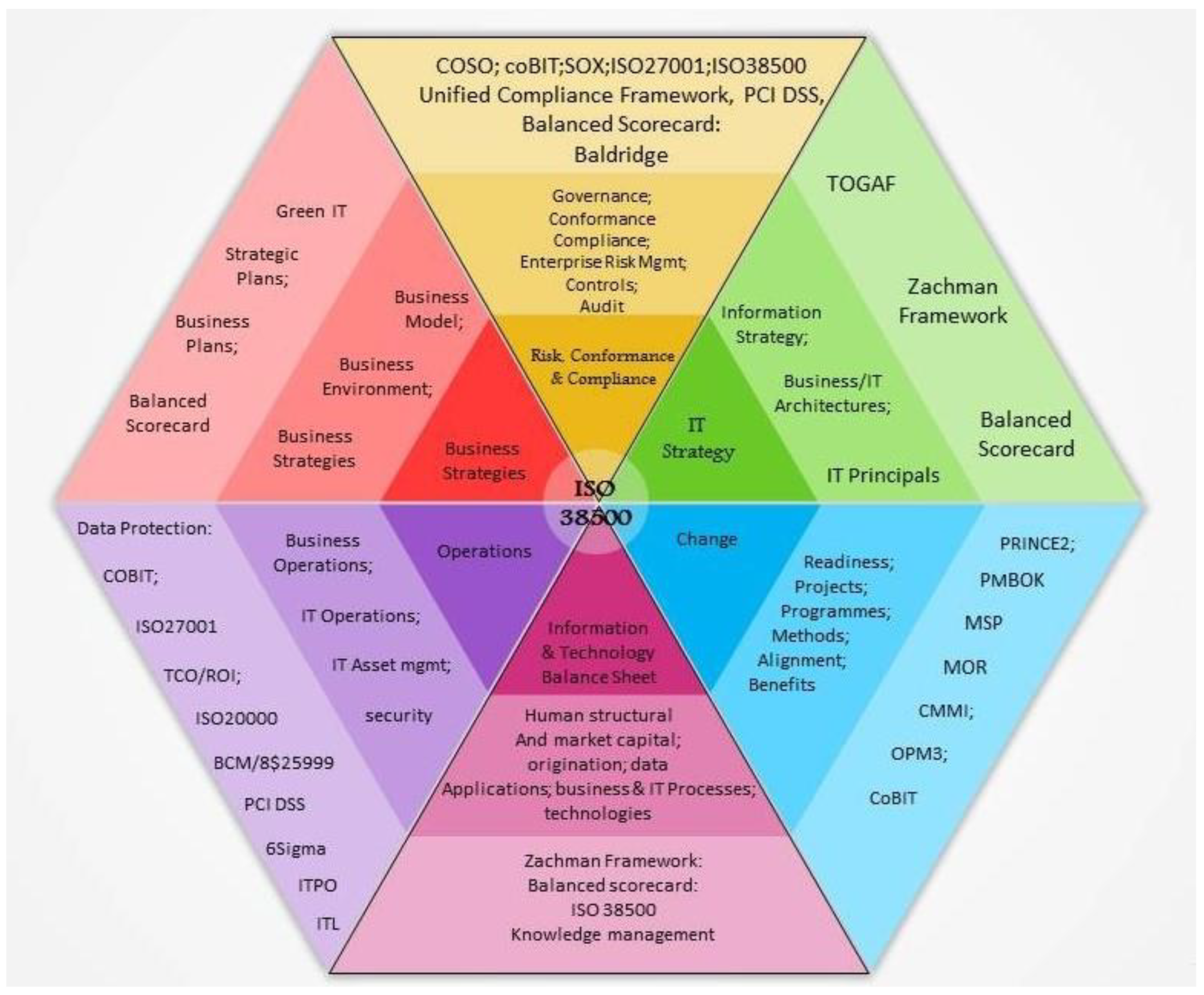
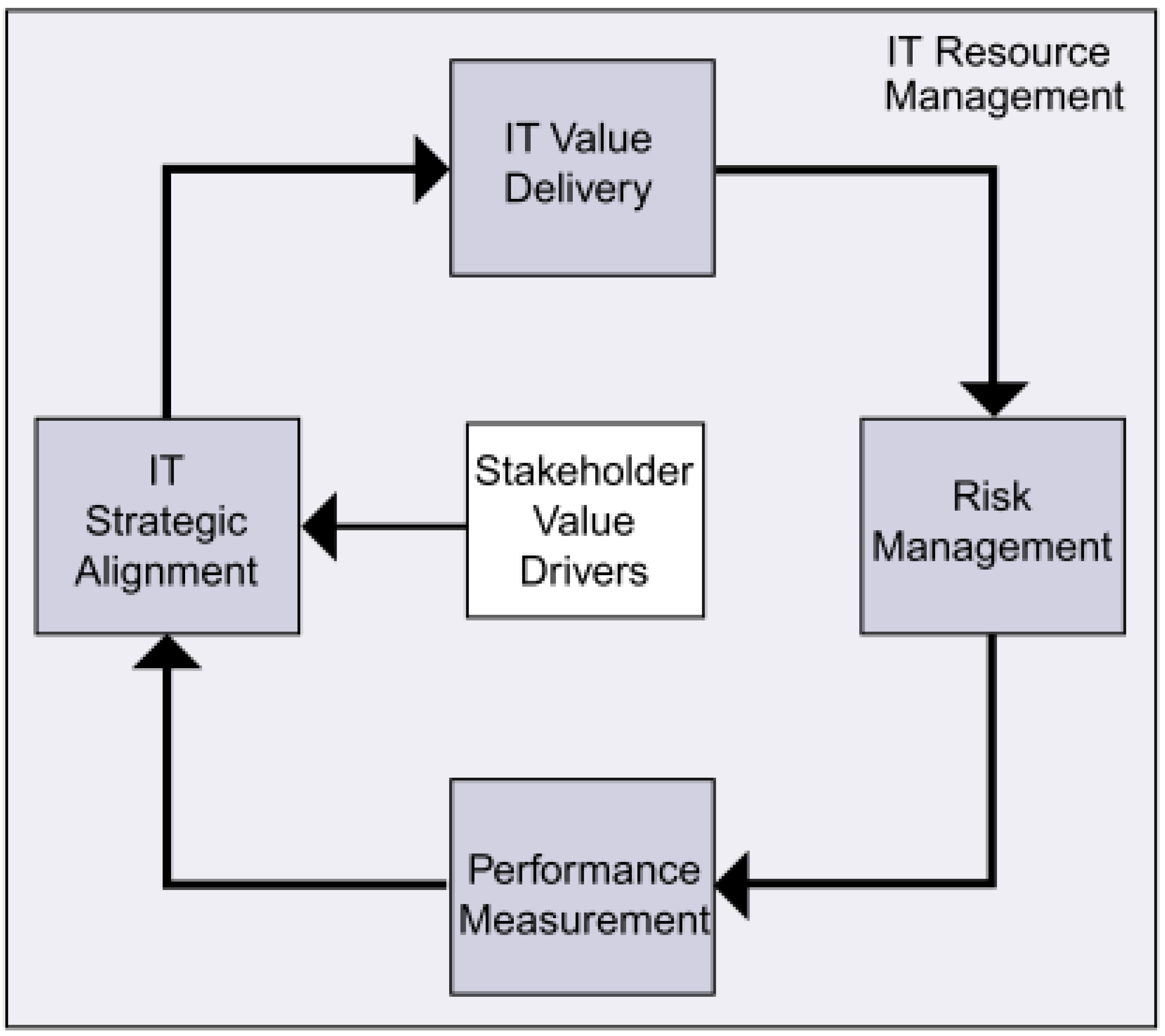
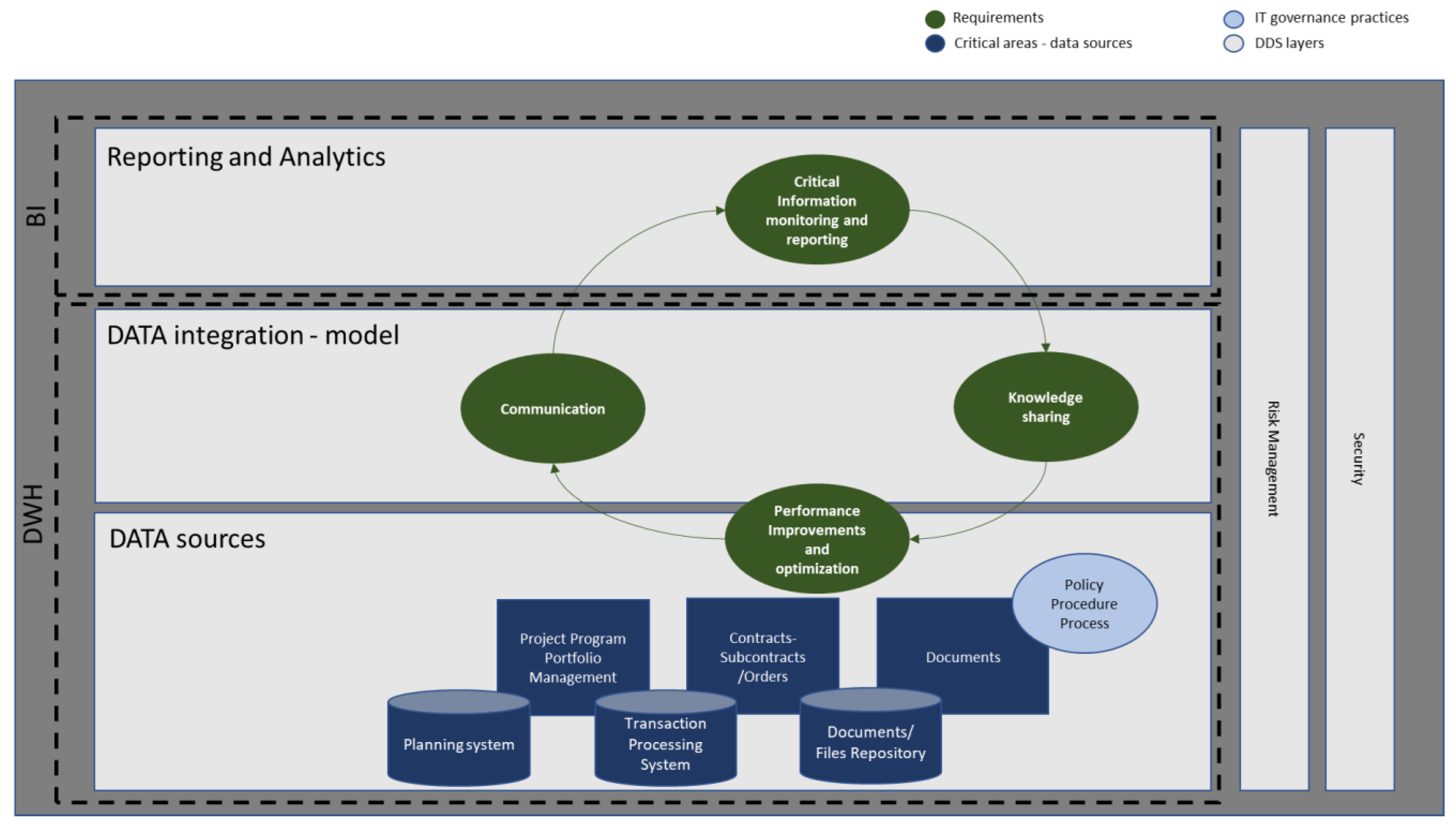
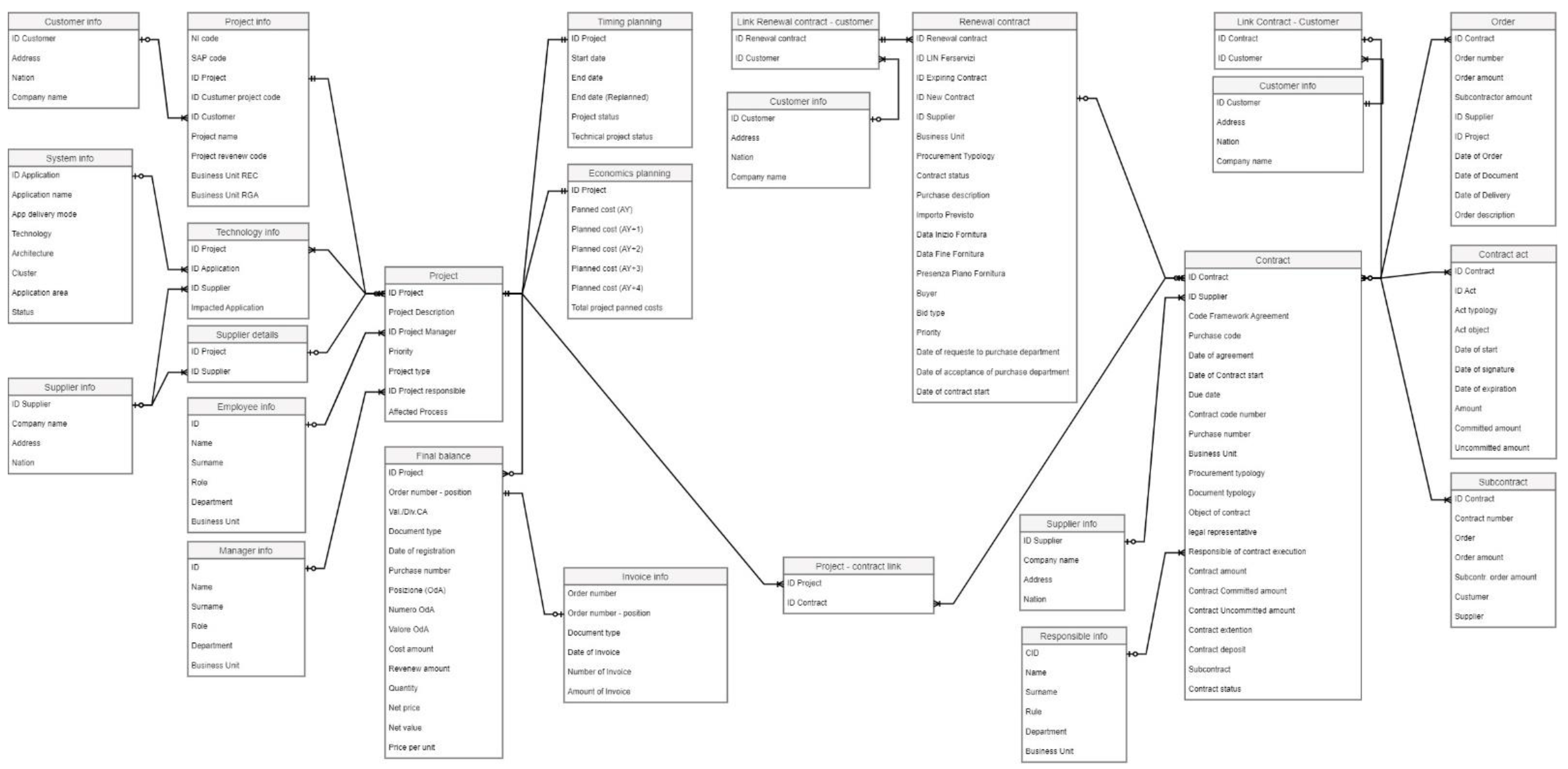
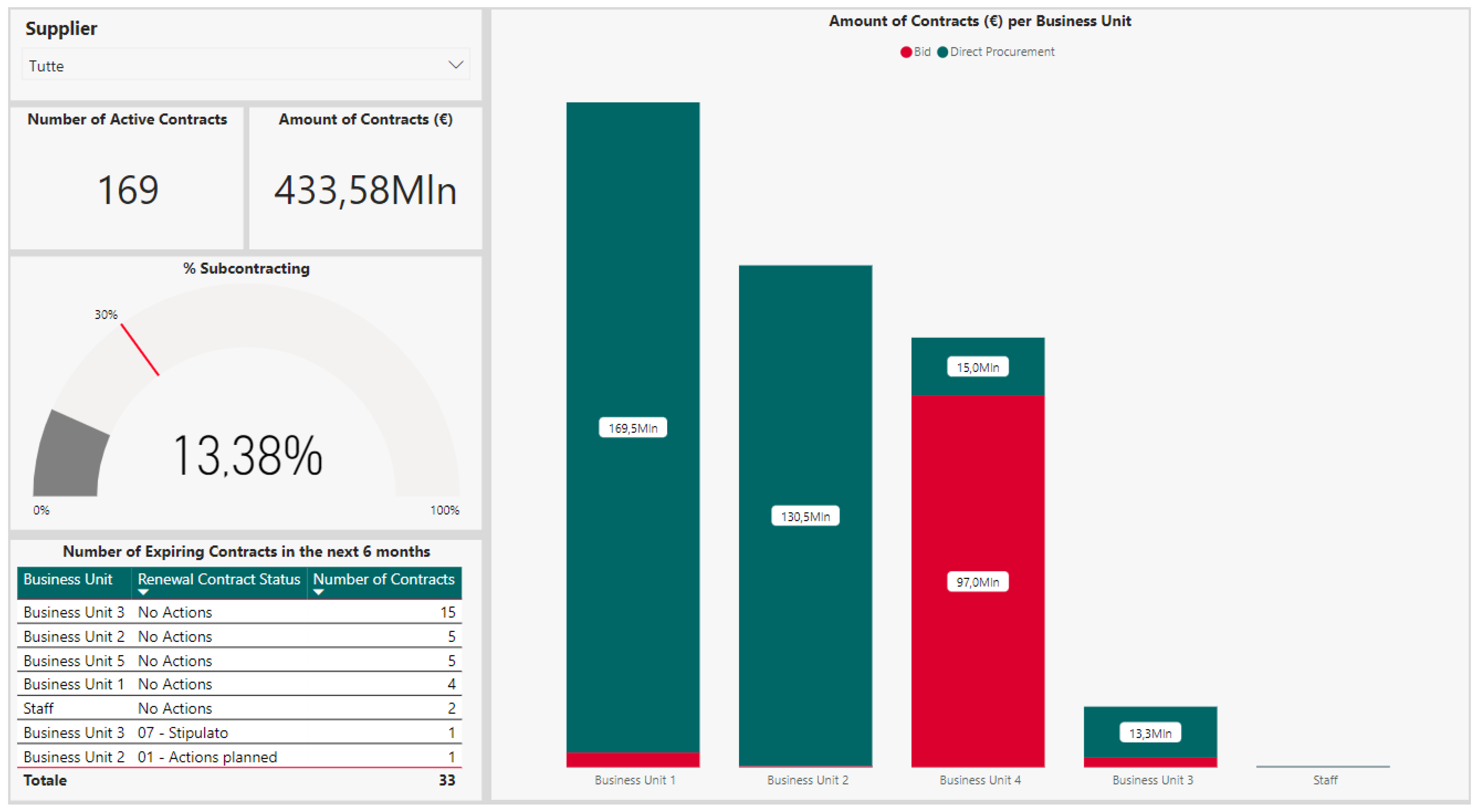
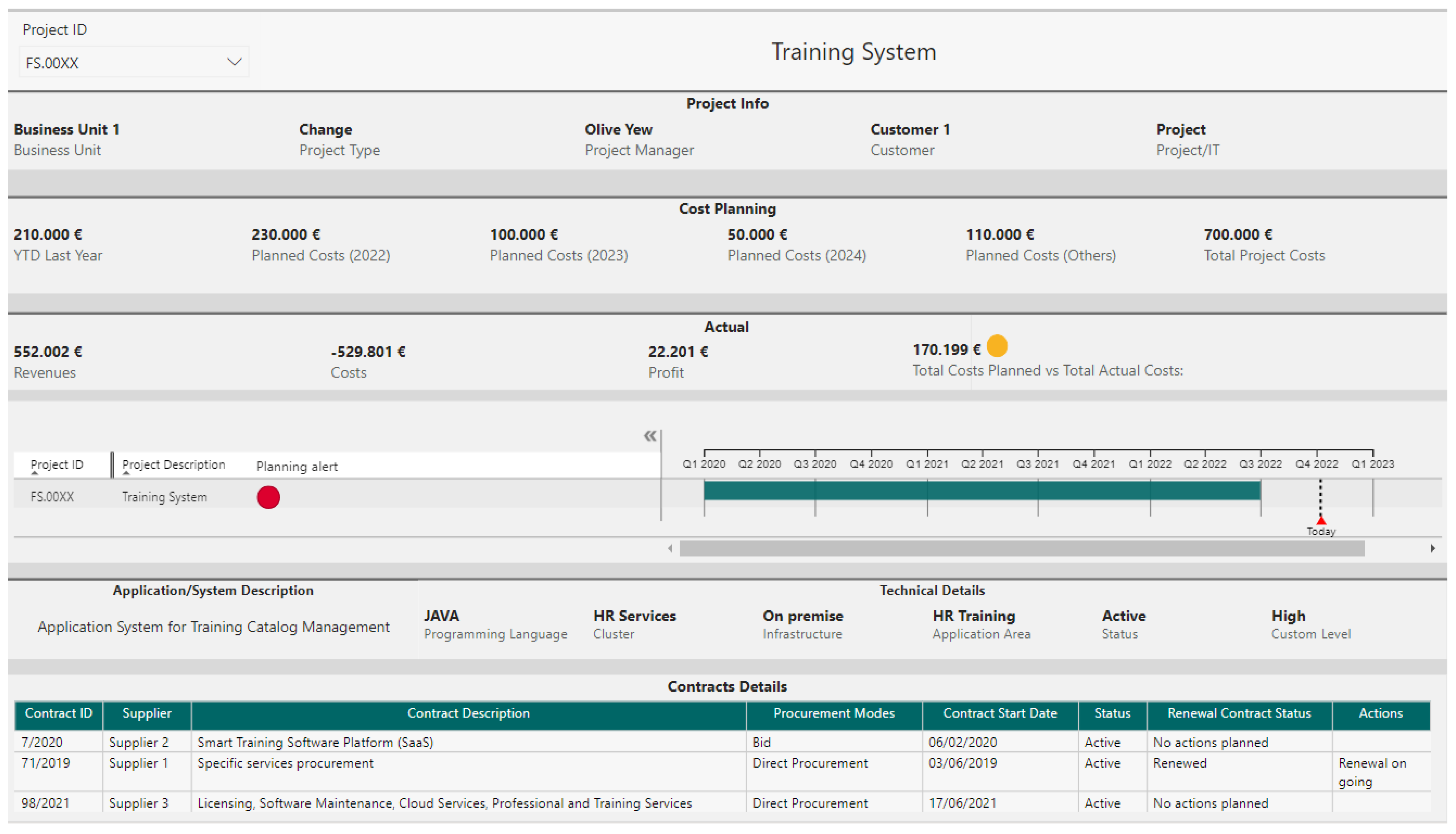
| BI | Big Data | |
|---|---|---|
| Data Sources | Mostly internal | Mostly external |
| Data Types | Mostly structured | Unstructured |
| History | Essential | Less relevant |
| Users | Managers/Controller | Data scientist |
| Precision | Exact results | Approximate results |
| Privacy | Not critical | Critical |
| Control over data | Almost full control | Little or no control |
Publisher’s Note: MDPI stays neutral with regard to jurisdictional claims in published maps and institutional affiliations. |
© 2022 by the authors. Licensee MDPI, Basel, Switzerland. This article is an open access article distributed under the terms and conditions of the Creative Commons Attribution (CC BY) license (https://creativecommons.org/licenses/by/4.0/).
Share and Cite
Biagi, V.; Russo, A. Data Model Design to Support Data-Driven IT Governance Implementation. Technologies 2022, 10, 106. https://doi.org/10.3390/technologies10050106
Biagi V, Russo A. Data Model Design to Support Data-Driven IT Governance Implementation. Technologies. 2022; 10(5):106. https://doi.org/10.3390/technologies10050106
Chicago/Turabian StyleBiagi, Vittoria, and Angela Russo. 2022. "Data Model Design to Support Data-Driven IT Governance Implementation" Technologies 10, no. 5: 106. https://doi.org/10.3390/technologies10050106
APA StyleBiagi, V., & Russo, A. (2022). Data Model Design to Support Data-Driven IT Governance Implementation. Technologies, 10(5), 106. https://doi.org/10.3390/technologies10050106






